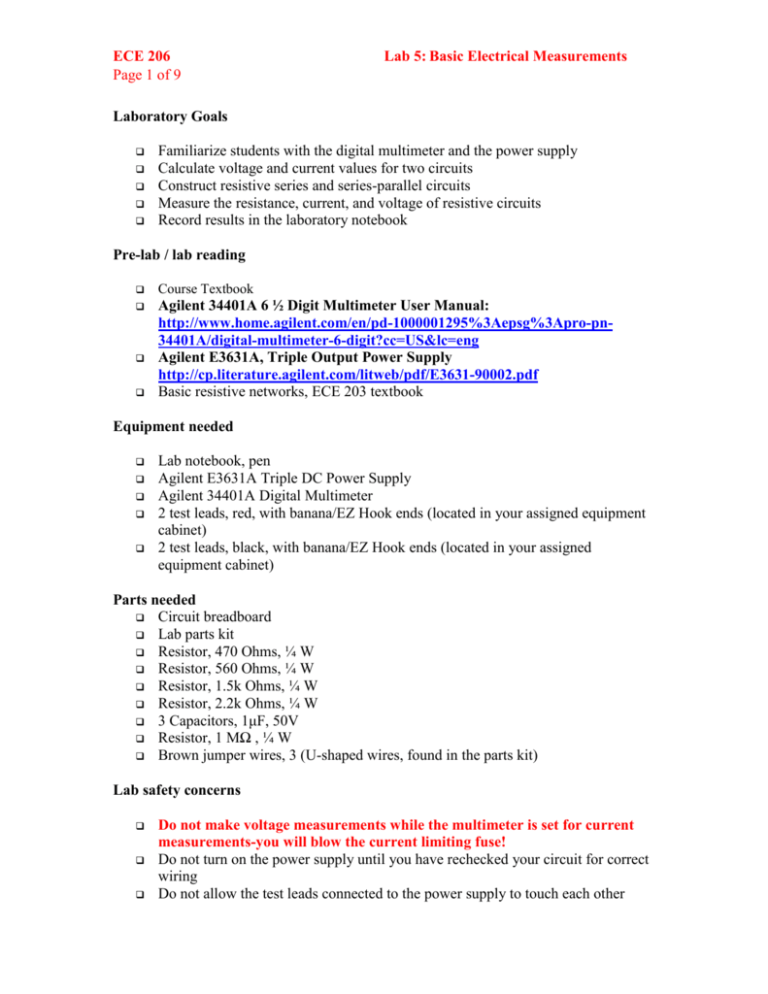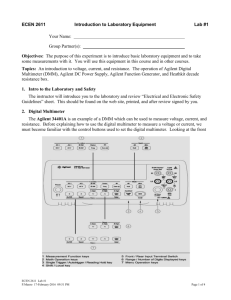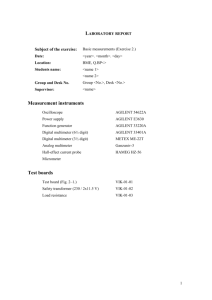ECE 206 Lab 5
advertisement

ECE 206 Page 1 of 9 Lab 5: Basic Electrical Measurements Laboratory Goals Familiarize students with the digital multimeter and the power supply Calculate voltage and current values for two circuits Construct resistive series and series-parallel circuits Measure the resistance, current, and voltage of resistive circuits Record results in the laboratory notebook Pre-lab / lab reading Course Textbook Agilent 34401A 6 ½ Digit Multimeter User Manual: http://www.home.agilent.com/en/pd-1000001295%3Aepsg%3Apro-pn34401A/digital-multimeter-6-digit?cc=US&lc=eng Agilent E3631A, Triple Output Power Supply http://cp.literature.agilent.com/litweb/pdf/E3631-90002.pdf Basic resistive networks, ECE 203 textbook Equipment needed Lab notebook, pen Agilent E3631A Triple DC Power Supply Agilent 34401A Digital Multimeter 2 test leads, red, with banana/EZ Hook ends (located in your assigned equipment cabinet) 2 test leads, black, with banana/EZ Hook ends (located in your assigned equipment cabinet) Parts needed Circuit breadboard Lab parts kit Resistor, 470 Ohms, ¼ W Resistor, 560 Ohms, ¼ W Resistor, 1.5k Ohms, ¼ W Resistor, 2.2k Ohms, ¼ W 3 Capacitors, 1μF, 50V Resistor, 1 MΩ , ¼ W Brown jumper wires, 3 (U-shaped wires, found in the parts kit) Lab safety concerns Do not make voltage measurements while the multimeter is set for current measurements-you will blow the current limiting fuse! Do not turn on the power supply until you have rechecked your circuit for correct wiring Do not allow the test leads connected to the power supply to touch each other ECE 206 Page 2 of 9 Lab 5: Basic Electrical Measurements 1. Pre-Lab Design Calculations Measure R1, R2, & 10V then calculate IR1, IR2, VR1, and VR2 for Circuit 1: Figure 1: Circuit 1 Next, Measure R1, R2, R3, R4, & 10V then calculate IR1, IR2, IR3/IR4, VR1, VR2, VR3, and VR4 for Circuit 2: Figure 2: Circuit 2 Create two tables in your lab notebook, with the headings shown below. (Be sure to make five columns: Characteristic(voltage-V1 or current I2), Expected Value, Measured Value, Error, %Error, Comment (error large because) and a row for each of the values listed below: Circuit #1 Vin R1 R2 IR1 IR2 VR1 VR2 Circuit #2 Vin R1 R2 R3 R4 IR1 IR2 IR3 IR4 VR1 VR2 VR3 VR4 Copy the calculated values for circuits 1 and 2 into the tables ECE 206 Page 3 of 9 Lab 5: Basic Electrical Measurements 2. Circuits 1 and 2 Construction Build circuit 2 exactly as shown below (bend the brown jumper wires as shown; these wires are later removed for resistance and current measurements). Resistors are found in the resistor drawers. If exact value is not available them substitute the nearest available value, note the new values in the procedure, and use this device’s measured value in all relevant calculations. R1 R3 J1 J2 R2 J3 R4 Figure 3: Circuits 1 and 2 3. Resistance and Voltage Measurement using the Multimeter Locate the Agilent 34401A Digital Multimeter Press the white Power button to turn on the multimeter Confirm that the gray Terminals button is out (i.e., the front terminals are active) o Note that there are two sets of identical terminals in the front and back of the multimeter. The rear terminals have probes already plugged in and are ECE 206 Page 4 of 9 Lab 5: Basic Electrical Measurements typically set for voltage and resistance measurements. We will use the front terminals for today’s lab, so the button is out Connect a pair of red and black test leads to the multimeter as shown below for resistance and voltage measurements: The Digital Multimeter set for Resistance and Voltage Measurements Press the white 2W button to select the resistance measurement mode Briefly clip the two test leads together (The multimeter reads approximately zero Ohms. Always test the probes before relying on them!) To make resistance measurements with the multimeter: o o o o Remove the jumper wire (J3) from between R3 and R4 Clip the red test lead to either of the legs of resistor R1 Clip the black test lead to the other leg of R1 Record the resistance value shown on the multimeter in your lab notebook (e.g., 471.92 Ohms will read as .471.92KOHMS) o Unclip the two test leads from R1 and repeat the measurement for the other 3 resistors o Unclip the two test leads from the last resistor measured, and set them aside Locate the Agilent E3631A Triple DC Power Supply Press the white Power button to turn on the power supply To set the power supply to +10VDC: o o o o Press the Output On/Off button to enable the power supply output Press the +25V button to select the +/- 25V power supply Turn the ADJUST dial clockwise until the display shows “10.00V” Press the Output On/Off button to disable the power supply output Connect the second pair of red and black test leads between the power supply and the circuit as shown below: The Power Supply Connected to the Circuit Press the power supply’s Output On/Off button to provide power to the circuit To take DC voltage measurements of R1 and R2 with the multimeter: ECE 206 Page 5 of 9 Lab 5: Basic Electrical Measurements o o o o Press the DC V button to select the DC voltage measurement mode Clip the red test lead from the multimeter to one leg of R1 Clip the black test lead from the multimeter to the other leg of R1 Record the voltage drop VR1 in your table (a negative voltage means that you have the probes reversed from the correct polarity-change them!) o Repeat the voltage measurement for R2 Measure the circuit input voltage by connecting the multimeter test leads to the same points where the power supply is connected to the circuit. Record the value Press the Output On/Off button to disable the power supply output Unclip the multimeter test leads from the circuit Reinstall jumper wire J3 to complete circuit 2 Press the power supply’s Output On/Off button to provide power to the circuit Take voltage measurements of the resistors in circuit 2 using the same procedure as above (be sure to include R1 and R2, since the voltages are different from those in circuit 1) Measure the circuit input voltage for circuit 2, and record the value Press the Output On/Off button to disable the power supply output Unclip the multimeter test leads from the circuit 4. Current Measurement using the Multimeter Do not make voltage measurements while the multimeter is set for current measurements-you will blow the current limiting fuse! To make DC current measurements with the multimeter: o Remove the red test lead from the V input on the front panel o Connect the red test lead to the I input (below the black test lead connection) o Press the blue Shift button, followed by the DC I button Remove jumper wire (J3) Remove jumper wire (J2) Clip the red test lead of the multimeter to the left leg of R3 Clip the black test lead of the multimeter to the top leg of R2 (the multimeter is now ready to measure the series current for circuit 1) Press the power supply’s Output On/Off button to provide power to the circuit Record the current shown on the multimeter for IR1/IR2 of circuit 1 Press the Output On/Off button to disable the power supply output ECE 206 Page 6 of 9 Lab 5: Basic Electrical Measurements Reinstall jumper wire (J3) Press the power supply’s Output On/Off button to provide power to the circuit Record the current shown on the multimeter for IR2 of circuit 2 Press the Output On/Off button to disable the power supply output Unclip the multimeter test leads from the circuit Reinstall jumper wire (J2) Remove jumper wire (J1) Clip the red test lead of the multimeter to the right leg or R1 Clip the black test lead of the multimeter to the left leg of R3 Press the power supply’s Output On/Off button to provide power to the circuit Record the current shown on the multimeter for IR1 of circuit 2 Press the Output On/Off button to disable the power supply output Unclip the multimeter test leads from the circuit Reinstall jumper wire (J1) Remove jumper wire (J3) Clip the red test lead of the multimeter to the right leg or R3 Clip the black test lead of the multimeter to the top leg of R4 Press the power supply’s Output On/Off button to provide power to the circuit Record the current shown on the multimeter for IR3/IR4 of circuit 2 Press the Output On/Off button to disable the power supply output After all the measurements are recorded, disconnect the test leads from the circuit and turn off the equipment. You are done! Before leaving the lab, take a few minutes to make sure all equipment and test leads are returned to your cabinet, and then lock it. Return the cabinet key to your T.A. Pick up any loose parts on the workstation table, and wipe off any eraser shavings, or other debris with a paper towel. Dispose of the paper towel and debris in the wastebasket. 4. Capacitor Voltage Measurements using DMM This experiment will demonstrate how parallel capacitors sum their capacitance and how voltage divides between series capacitors. Capacitors connected in parallel result in a capacitance equal to the sum of their individual capacitance. Cp = C1 + C2 Capacitors connected in series result in a capacitance equal the inverse of the sum of the inverse of their individual capacitance. Cs = 1/( (1/C1) + (1/C2) ). ECE 206 Page 7 of 9 Lab 5: Basic Electrical Measurements Parallel Capacitors have the same voltage across each capacitor. Series Capacitors divide the voltage between them such that, the voltage on a capacitor is proportional to the total capacitance divided by the capacitance of capacitor with the voltage of interest. VCx = Vs(Cs/Cx). Before starting calculate the expected values for the voltage readings for circuit 3. Show your work in the report and record the values in the results table. V1 reading and the Vc3, voltage across capacitor 3 in circuit 3. Also Calculate the Voltage on C3 if C1 were removed. Build Circuit 3 on the ELVIS II+ prototype board Figure 4: Circuit 3 Parallel/Series Capacitor Circuit Step 1: select and measure 3, 1 μF Capacitors ( or a set of Capacitors Near 1μF) and a 1 MΩ resistor Step 2: record the capacitances values and keep track of which cap has which value. Step 3: Build Circuit 3, figure 4, on the lower left of the ELVIS prototype board, but we will use the Agilent Multimeter to make our measurements. Step 4: Start the ELVIS II+ software and from the NI ELVISmx Instrument Launcher, launch the Function Generator, FGEN. Step 3: Connect the ELVIS Function Generator to you circuit as shown using jumper wires from row 33 of the lower terminal strip to the top of the two parallel capacitors and the ground from row 53. Step 4: Connect the black lead of the Agilent 34401A Multimeter to the circuit 3 ground and the red (VΩ [diode]) lead to the top of the parallel capacitors where the Function Generator is connected. ECE 206 Page 8 of 9 Lab 5: Basic Electrical Measurements Figure 5: Capacitor Measurements & Function Generator Connection Step 5: Turn ON Power to the Agilent meter and press the ACV button (second button from the left top row) This will read TRUE RMS. Step 6: On the NI ELVISmx Function Generator window: a. Click the sine wave button (top left button) b. Set the frequency to ~ 60 Hz c. Set the Amplitude to 10 Vpp d. Set the DC Offset to 0 V e. Set Modulation Type to None f. Set Signal Route to “Prototyping Board” g. Click the Run button Step 7. Turn ON to the ELVIS Prototype Board. Step 8: Read the Agilent Meter Display for the Vs, source voltage, and record the value Step 9: Move the Red Agilent Meter lead to the top of C3 and read the C3 capacitor voltage. See Figure 6. Figure 6: Measurement Connections for Cap 3 Voltage. ECE 206 Page 9 of 9 Lab 5: Basic Electrical Measurements Step 10: Record the reading in the results table. Step 11: Turn OFF the Prototype Board Power Supply. Step 12: Remove Capacitor 1 ,C1, Step 13: Turn On the Prototype Board Power Supply Step 14: Read the New Voltage across Capacitor 3, C3, from the Agilent Multimeter. Step 15: Record the reading in the results table. Step 16: Determine if any of the readings have significant errors and if so track down the cause. 4. Analysis Write a Lab Report for this lab. Be sure to also include the following topics: Compare theoretical vs. measured values. Are there differences? If so, why? What are some types of errors possible when making measurements with a DMM? (see the back of the Agilent Multimeter User Manual. Explain any difficulties you had with this lab. (Please include suggestions to improve the lab, if you have them). Updated 02-12-13 by David Modisette:







